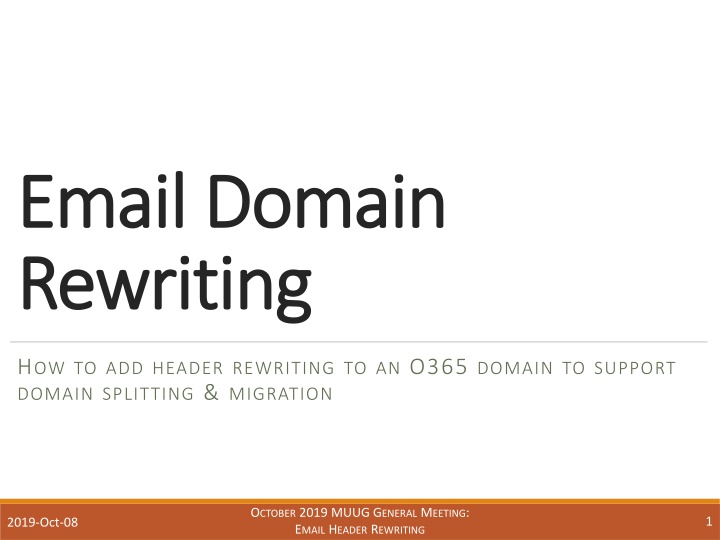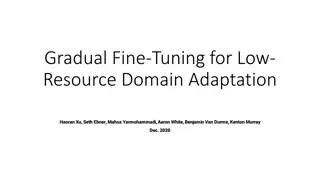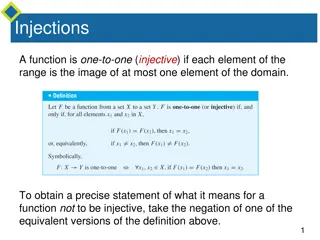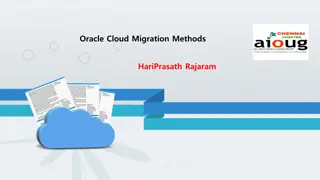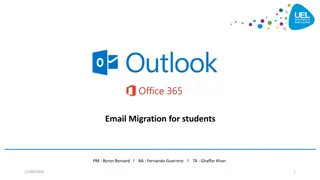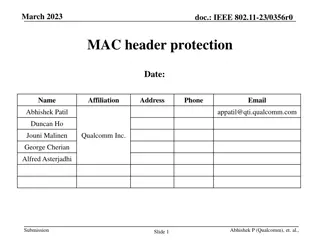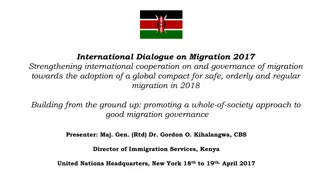Adding Header Rewriting to an O365 Domain for Domain Splitting & Migration
Learn how to add header rewriting to an Office 365 domain to support domain splitting and migration. Explore a proposed solution using OpenBSD, OpenSMTPd, and Postfix in the cloud, specifically on OVH. Understand the components involved in this cost-effective and scalable setup for managing email domains effectively during organizational restructuring.
Download Presentation

Please find below an Image/Link to download the presentation.
The content on the website is provided AS IS for your information and personal use only. It may not be sold, licensed, or shared on other websites without obtaining consent from the author.If you encounter any issues during the download, it is possible that the publisher has removed the file from their server.
You are allowed to download the files provided on this website for personal or commercial use, subject to the condition that they are used lawfully. All files are the property of their respective owners.
The content on the website is provided AS IS for your information and personal use only. It may not be sold, licensed, or shared on other websites without obtaining consent from the author.
E N D
Presentation Transcript
Email Domain Email Domain Rewriting Rewriting HOW TO ADD HEADER REWRITING TO AN O365 DOMAIN TO SUPPORT DOMAIN SPLITTING & MIGRATION OCTOBER 2019 MUUG GENERAL MEETING: EMAIL HEADER REWRITING 1 2019-Oct-08
Thanks / Credits Thanks / Credits Thanks to BTW Technology Solutions for: Their business and trust Use of their documentation in this live presentation Not included with the online copy, sorry. Permission to discuss the solution here! OCTOBER 2019 MUUG GENERAL MEETING: EMAIL HEADER REWRITING 2 2019-Oct-08
The Problem The Problem Large media org was reorganizing, splitting off a subsidiary needed to maintain their corporate access for a while also needed to start sending email under their new domain name Office 365 tenants on both end of this migration process Office 365 supports multiple domain-name aliases, cool! but only for inbound mail. Each user gets one primary domain and that gets used for outbound mail A more flexible solution was needed! OCTOBER 2019 MUUG GENERAL MEETING 3 2019-Oct-08
The Proposed Solution The Proposed Solution Well, if Microsoft can t do it, surely UNIX can, right? Quick proof-of-concept using OpenBSD and OpenSMTPd, because it s super-small footprint, trivial to configure, and doesn t need hardening. Success (sort of)! OpenSMTPd is still too lean to support all the arbitrary rewriting we want. So let s use Postfix instead, because I m familiar with it. Oh, and since we re running in the cloud, maybe use an OS that s supported by the cloud vendor CentOS and/or Debian both provide adequate stability, longevity and supportability And since this could go months/years before it gets re-used, a cheap cloud So let s use OVH, instead of Azure or IBM or even AWS. Needs to be easily scalable Needs to be both documented and reproducible So let s use Ansible for pretty much everything. OCTOBER 2019 MUUG GENERAL MEETING 4 2019-Oct-08
Solution Components Solution Components VM(s) in OVH Public Cloud Cost-effective. Very cost-effective compared to other options. Multiple locations available in regions to (approximately) match O365 regions, for minimum latency IPv4 + IPv6 Stable public IP addresses including control over PTRs for both v4 and v6 assuming that part of the management UI isn t broken today Authentication is not a Lovecraftian nightmare (like AWS) admittedly, OVH s auth model is nowhere near flexible enough for more sensitive use cases Good enough! OCTOBER 2019 MUUG GENERAL MEETING 5 2019-Oct-08
Debian vs. CentOS Debian vs. CentOS I honestly don t remember why Minor advantages: Longer projected support period Larger selection of precompiled software Bundled software is more up-to-date than CentOS (and all ELs) Easier to override cloud-init for networking setup cloud-init did some things in the wrong order and/or too late in the boot process for a dual-stack mail server. Might be OVH-specific, dunno. OCTOBER 2019 MUUG GENERAL MEETING: EMAIL HEADER REWRITING 6 2019-Oct-08
Network Configuration Network Configuration Cloud providers universally use cloud-init. Cloud-init is great, except when it isn t. Luckily you can override it by creating one tiny file, then managing it like you normally would. assuming your VM doesn t get new private IPs on every boot, anyway. In this case, having a LESS sophisticated cloud provider (OVH) worked out better. OCTOBER 2019 MUUG GENERAL MEETING: EMAIL HEADER REWRITING 7 2019-Oct-08
root@lon:~# cat /etc/cloud/cloud.cfg.d/99- disable-network-config.cfg network: {config: disabled} OCTOBER 2019 MUUG GENERAL MEETING: EMAIL HEADER REWRITING 8 2019-Oct-08
root@lon:~# cat /etc/network/interfaces ### source /etc/network/interfaces.d/* # The loopback network interface auto lo iface lo inet loopback # The primary network interface # allow-hotplug ens4 # iface ens4 inet dhcp auto ens3 iface ens3 inet static address 51.75.171.51/32 gateway 51.75.171.1 iface ens3 inet6 static address 2001:41d0:801:2000::1dff/64 gateway 2001:41d0:0801:2000:0000:0000:0000:0001 OCTOBER 2019 MUUG GENERAL MEETING: EMAIL HEADER REWRITING 9 2019-Oct-08
Ansible, for repeatability Ansible, for repeatability Here s the important Ansible files AKA playbooks Sorry about the formatting. Thank Microsoft Powerpoint. OCTOBER 2019 MUUG GENERAL MEETING: EMAIL HEADER REWRITING 10 2019-Oct-08
root@lon:/etc/ansible/playbooks# cat all.yml --- - hosts: all gather_facts: false - name: SSH keys import_playbook: ssh-keys.yml - name: APT packages import_playbook: packages.yml - name: make network settings static import_playbook: network.yml - name: force all Postfix variables import_playbook: postfix.yml - name: sync servers import_playbook: sync.yml # vim:set ts=2 sw=2 et nu ai si cursorcolumn: OCTOBER 2019 MUUG GENERAL MEETING: EMAIL HEADER REWRITING 11 2019-Oct-08
- name: add packages package: name: "{{ packages }}" state: latest vars: packages: - ansible - apt-listchanges - bash-completion - bind9-host - binutils - bsd-mailx - certbot - cpp - curl - dnsutils - less - locales-all - locate - mtr-tiny - ncdu - needrestart - netcat-openbsd - netselect - netselect-apt - perl - postfix - postfix-doc - postfix-pcre - postfix-sqlite - psmisc - psutils - python-apt-common - python3-apt - rcs - swaks - unattended-upgrades - vim-nox - xz-utils - git - rsync root@lon:/etc/ansible/playbooks# cat packages.yml --- - hosts: all gather_facts: false tasks: - name: pre-add Ansible repo key apt_key: keyserver: keyserver.ubuntu.com id: 93C4A3FD7BB9C367 - name: configure APT repositories apt_repository: repo: "{{ item }}" state: present loop: - "deb http://debian.mirrors.ovh.net/debian stretch main contrib non- free" - "deb-src http://debian.mirrors.ovh.net/debian stretch main contrib non- free" - "deb http://security.debian.org/ stretch/updates main contrib non-free" - "deb-src http://security.debian.org/ stretch/updates main contrib non- free" - "deb http://debian.mirrors.ovh.net/debian stretch-updates main contrib non-free" - "deb-src http://debian.mirrors.ovh.net/debian stretch-updates main contrib non-free" - "deb http://debian.mirrors.ovh.net/debian stretch-backports main contrib non-free" - "deb-src http://debian.mirrors.ovh.net/debian stretch-backports main contrib non-free" - "deb http://ppa.launchpad.net/ansible/ansible/ubuntu trusty main" # vim:set ts=2 sw=2 et nu ai si cursorcolumn: OCTOBER 2019 MUUG GENERAL MEETING: EMAIL HEADER REWRITING 12 2019-Oct-08
root@lon:/etc/ansible/playbooks# cat all.yml --- - hosts: all gather_facts: false - name: SSH keys import_playbook: ssh-keys.yml - name: APT packages import_playbook: packages.yml - name: make network settings static ## still done by hand import_playbook: network.yml - name: force all Postfix variables import_playbook: postfix.yml - name: sync servers import_playbook: sync.yml # vim:set ts=2 sw=2 et nu ai si cursorcolumn: OCTOBER 2019 MUUG GENERAL MEETING: EMAIL HEADER REWRITING 13 2019-Oct-08
- name: set Postfix options command: args: argv: - "postconf" - "-e" - "alias_maps=hash:/etc/aliases" - "compatibility_level=2" - "debug_peer_level=99" - "debug_peer_list=127.0.0.1, home.athompso.net, 204.16.144.114, [2620:132:300e:700::]/64" - "lmtp_tls_security_level=may" - "local_header_rewrite_clients=static:all" - "mydestination=$myhostname, localhost.$mydomain, localhost, $mydomain" - "mynetworks=127.0.0.0/8, cidr:/etc/postfix/allow_relay_by_ip" - "sender_dependent_relayhost_maps=hash:/etc/postfix/per_sender_relayhosts" - "sender_canonical_maps=hash:/etc/postfix/translate_domains" - "smtpd_sender_restrictions=check_sender_access hash:/etc/postfix/allowed_senders, reject" - "smtpd_tls_cert_file=/etc/letsencrypt/live/{{ ansible_hostname }}.header-rewrite.net/fullchain.pem" - "smtpd_tls_key_file=/etc/letsencrypt/live/{{ ansible_hostname }}.header-rewrite.net/privkey.pem" - "smtpd_tls_loglevel=1" - "smtpd_tls_received_header=yes" - "smtpd_tls_security_level=encrypt" - "smtp_tls_loglevel=1" - "smtp_tls_security_level=may" - "message_size_limit=153600000" root@lon:/etc/ansible/playbooks# cat postfix.yml --- - hosts: all gather_facts: true tasks: - name: unset /etc/mailname file: path: /etc/mailname state: absent - name: sync /etc/postfix directories synchronize: checksum: yes src: /etc/postfix/. dest: /etc/postfix/. - name: reset Postfix config completely command: truncate --size=0 /etc/postfix/main.cf - name: rebuild postfix databases command: postconf {{ item }} loop: - /etc/postfix/allowed_senders - /etc/postfix/per_sender_relayhosts - /etc/postfix/translate_domains - name: restart postfix service: name: postfix state: restarted # vim:set ts=2 sw=2 et nu ai si cursorcolumn: OCTOBER 2019 MUUG GENERAL MEETING: EMAIL HEADER REWRITING 14 2019-Oct-08
root@lon:/etc/ansible/playbooks# cat sync.yml --- - hosts: all gather_facts: false tasks: - name: synchronize ansible (1st pass) synchronize: checksum: yes src: /etc/ansible/. dest: /etc/ansible/. - name: add changes to git local_action: command git add -A args: chdir: /etc/ansible run_once: true - name: check for changes to git local_action: command git diff-index --quiet HEAD run_once: true register: gitdiff failed_when: gitdiff.rc > 1 - name: commit changes to git local_action: command git commit -a -m "Ansible automatic commit" -q args: chdir: /etc/ansible run_once: true when: gitdiff.rc == 1 - name: synchronize ansible (2nd pass) synchronize: checksum: yes src: /etc/ansible/. dest: /etc/ansible/. - name: synchronize certbot synchronize: checksum: yes src: /etc/letsencrypt/. dest: /etc/letsencrypt/. # vim:set ts=2 sw=2 et nu ai si cursorcolumn: OCTOBER 2019 MUUG GENERAL MEETING: EMAIL HEADER REWRITING 15 2019-Oct-08
Ansible tricks 1 Ansible tricks 1 synchronize module: Src is always local to <machine ansible runs on> Dst is always local to <machine ansible is targeting> Uses rsync under the hood local_action module: is how you extend Ansible for one-off cases that don t need their own entire new Ansible module run_once attribute: Only run on ONE host no matter how many are in the targeted group. OCTOBER 2019 MUUG GENERAL MEETING: EMAIL HEADER REWRITING 16 2019-Oct-08
Ansible tricks 2 Ansible tricks 2 command module to set config values with postconf(8) No need to use Ansible s loop: construct because postconf(8) takes arbitrarily-long lists of variables and values on the command-line. Could have used Ansible s flatten approach but figuring that out was more work than using the command module. OCTOBER 2019 MUUG GENERAL MEETING: EMAIL HEADER REWRITING 17 2019-Oct-08
Sync Process Sync Process Unidirectional sync process is scalable Assumes changes are only made on one system at a time. This works for this system where only one person is making changes at a time. Will probably not work for multi-actor systems, YMMV. Main sync process only handles Ansible files Keeps them in git, syncs git repo too Postfix playbook has its own rsync-only method No git Trivial to add, but wasn t needed. (History of non-Ansible- controlled files there had very little value.) OCTOBER 2019 MUUG GENERAL MEETING: EMAIL HEADER REWRITING 18 2019-Oct-08
Postfix translation 1 Postfix translation 1 Re-injection into O365 Required to handle DKIM, SPF, etc. O365 leaves SMTP headers alone (mostly) when sender is authenticated sender_dependent_relayhost Because O365 puts different tenants in different clusters, so you have to re-inject to the correct SMTP host. mynetworks= , allow_relay_by_ip O365 has no way to do authenticated SMTP outbound. This is not a good solution, but it is an adequate solution at this small scale. Both sender domain name and sending IP address must match, the attack scope is fairly small. OCTOBER 2019 MUUG GENERAL MEETING: EMAIL HEADER REWRITING 19 2019-Oct-08
Postfix Postfixtranslation 2 translation 2 Sender_canonical_maps This is the core function, and it s already built into Postfix! Basically a search-and-replace function for sender email addresses. Originally designed to translate internal-only hostnames into the canonical internet-visible email address. e.g. athompso@workstation.internal athompso@athompso.net But can be used for arbitrary re-writing Allowed_senders Trying to tighten up the security as much as possible Allows entire domain names, not just individual email addresses OCTOBER 2019 MUUG GENERAL MEETING: EMAIL HEADER REWRITING 20 2019-Oct-08
Geo Geo- -redundancy redundancy OVH has datacenters near Montreal, QC and London, England (plus many more) That s separated enough to survive any physical event! Easy part: DNS There s a two-valued A (and AAAA) record in the DNS zone; most MTAs will try each of the resolved IPs in some order. We don t care about 30-sec timeouts, this is all M2M SMTP at this point. Harder part: TLS OCTOBER 2019 MUUG GENERAL MEETING: EMAIL HEADER REWRITING 21 2019-Oct-08
TLS 1 TLS 1 Postfix supports TLS, no big deal. Letsencrypt provides free certs that auto-renew, if you use CertBot to set them up. So what s the problem? Canonical names. SMTP client connects to header- rewrite.net but TLS gets a cert for a CN of lon.header-rewrite.net . Oops. OCTOBER 2019 MUUG GENERAL MEETING: EMAIL HEADER REWRITING 22 2019-Oct-08
TLS 2 TLS 2 Solution: one cert with multiple valid hostnames! LE + Certbot lets you request a cert with multiple CNs. Tricky to automate, but still possible. Ultimately, we found a way to manually tell O365 to try this server, then that server. Much easier than managing one magic cert! O365 configuration is done by hand or by PowerShell, no big deal to specify two static server names! OCTOBER 2019 MUUG GENERAL MEETING: EMAIL HEADER REWRITING 23 2019-Oct-08
Results Results My client (the sub-contractor) was able to offer a solution to their client (the contractor), who was able to offer a solution to their client (the actual users who needed this function). That intermediary (a Very Large Enterprise tech consultancy) has since developed their own technology to do this in a more Microsoft-ish way. Reportedly the project manager said: This was the only piece of the entire project that worked properly the first time. Image credit: Charlie Cottrell, https://xeyeti.com/, https://charliecottrell.com/ OCTOBER 2019 MUUG GENERAL MEETING: EMAIL HEADER REWRITING 24 2019-Oct-08
